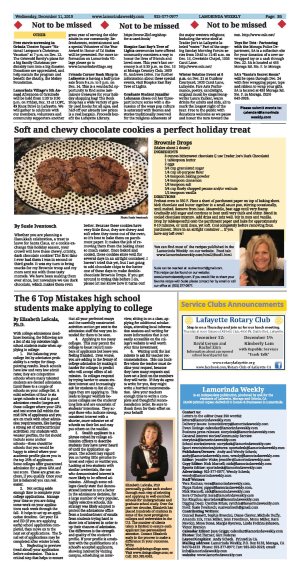| | Published December 11th, 2019
| The 6 Top Mistakes high school students make applying to college
| | | By Elizabeth LaScala, Ph.D. |  | | Elizabeth LaScala, PhD personally guides each student through each step of selecting and applying to well-matched schools for undergraduate and graduate school study. Over the past two decades, Elizabeth has placed hundreds of students in some of the most prestigious colleges and universities in the U.S. The number of clients taken is limited to ensure each applicant has personalized attention. Contact Elizabeth early in the process to make a difference in your outcomes. Write elizabeth@doingcollege.com; Visit www.doingcollege.com; or Call: 925.385.0562. |
With college admissions deadlines looming, the following are a list of six top mistakes high school students make when applying to college:
 1. Not balancing your college list by admission probability is a recipe for disappointing results. Reach schools have low and very low admit rates; they are competitive schools where many talented students are denied admission. Limit these to a couple of schools on your college list. A solid selection of four to six target schools is vital to good admission results (targets are those colleges where your GPA and test scores fall within the mid 50% of applicants and you are on track with other admission requirements, like having a strong set of extracurricular activities). For students with weaker profiles, the list should include some anchor schools-these should be schools that you would be happy to attend where your academic profile places you in the top 25% of applicants. Some colleges offer guaranteed admission for a given GPA and test score. These are great anchors, if you qualify. Once your list is balanced you can rest easier.
1. Not balancing your college list by admission probability is a recipe for disappointing results. Reach schools have low and very low admit rates; they are competitive schools where many talented students are denied admission. Limit these to a couple of schools on your college list. A solid selection of four to six target schools is vital to good admission results (targets are those colleges where your GPA and test scores fall within the mid 50% of applicants and you are on track with other admission requirements, like having a strong set of extracurricular activities). For students with weaker profiles, the list should include some anchor schools-these should be schools that you would be happy to attend where your academic profile places you in the top 25% of applicants. Some colleges offer guaranteed admission for a given GPA and test score. These are great anchors, if you qualify. Once your list is balanced you can rest easier.
 2. Not setting aside enough time to complete your college applications. Manage your time so you are doing some work on your applications each week through the fall. It helps to set up an application timeline. Get your EA and ED (if you are applying early) school application completed, then move on to the next set of applications. The final set of applications may be completed after winter break.
2. Not setting aside enough time to complete your college applications. Manage your time so you are doing some work on your applications each week through the fall. It helps to set up an application timeline. Get your EA and ED (if you are applying early) school application completed, then move on to the next set of applications. The final set of applications may be completed after winter break.
 3. Neglecting to preview (read aloud) your application before submission. This is a critical step that helps to ensure that all your perfected essays and the carefully constructed activities section get sent to the admission staff the way you intended for them to be seen.
3. Neglecting to preview (read aloud) your application before submission. This is a critical step that helps to ensure that all your perfected essays and the carefully constructed activities section get sent to the admission staff the way you intended for them to be seen.
 4. Applying to too many colleges. This may permit the college to boast record numbers of applicants but leave you feeling frazzled. Even worse, you are adding to the frenzy of college admission by making it harder for colleges to predict who will accept offers of admission. So colleges respond by trying harder to assess student interest and increasingly ask for students to list all colleges they are applying to. This leads to longer waitlists because colleges see the students' long lists and are uncertain of students' intentions. They accept those who indicate strong, consistent interest with a shorter, more cohesive set of schools on their list and may put others on the waitlist.
4. Applying to too many colleges. This may permit the college to boast record numbers of applicants but leave you feeling frazzled. Even worse, you are adding to the frenzy of college admission by making it harder for colleges to predict who will accept offers of admission. So colleges respond by trying harder to assess student interest and increasingly ask for students to list all colleges they are applying to. This leads to longer waitlists because colleges see the students' long lists and are uncertain of students' intentions. They accept those who indicate strong, consistent interest with a shorter, more cohesive set of schools on their list and may put others on the waitlist.
 5. Stealth applicant is a phrase coined by college admission officers to describe students they have never heard of until the application appears. The school may regard you as having little genuine interest and reject or waitlist you. Looking at two students with similar credentials, the one who demonstrated interest is more likely to be offered admission. Although some colleges clearly state that demonstrated interest is not a factor in the admissions decision, for a large number of very popular, highly selective schools, this strategy was likely adopted to protect the admissions office from a bombardment of emails from students trying hard to show lots of interest in order to up their chances of admission. The difference is the strength and quality of the student's profile. If your profile is consistent with the qualifications of a school's accepted applicants, showing interest by visiting campus, scheduling an interview, sitting in on a class, applying for additional scholarships, attending local information sessions and writing for more information that is not easily accessible on the college's website is well worth your time investment.
5. Stealth applicant is a phrase coined by college admission officers to describe students they have never heard of until the application appears. The school may regard you as having little genuine interest and reject or waitlist you. Looking at two students with similar credentials, the one who demonstrated interest is more likely to be offered admission. Although some colleges clearly state that demonstrated interest is not a factor in the admissions decision, for a large number of very popular, highly selective schools, this strategy was likely adopted to protect the admissions office from a bombardment of emails from students trying hard to show lots of interest in order to up their chances of admission. The difference is the strength and quality of the student's profile. If your profile is consistent with the qualifications of a school's accepted applicants, showing interest by visiting campus, scheduling an interview, sitting in on a class, applying for additional scholarships, attending local information sessions and writing for more information that is not easily accessible on the college's website is well worth your time investment.
 6. Waiting until the last minute to ask for teacher recommendations. This can backfire when the teacher must decline your request, because they have many requests and have set a limit on the numbers they will write. If they do agree to write for you, they might write a hurried recommendation. Give your teachers enough time to write a complete and thoughtful recommendation letter. Be sure to thank them for their effort on your behalf!
6. Waiting until the last minute to ask for teacher recommendations. This can backfire when the teacher must decline your request, because they have many requests and have set a limit on the numbers they will write. If they do agree to write for you, they might write a hurried recommendation. Give your teachers enough time to write a complete and thoughtful recommendation letter. Be sure to thank them for their effort on your behalf! |
| | | | | | | | | | | | |



